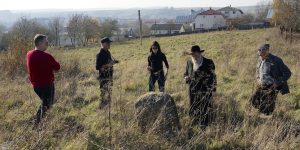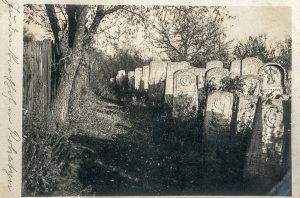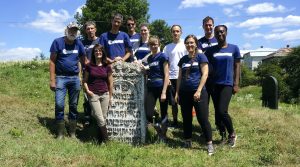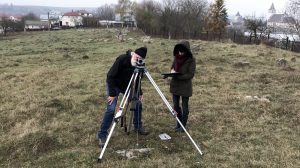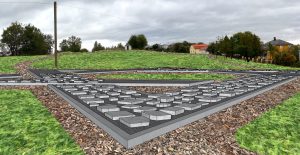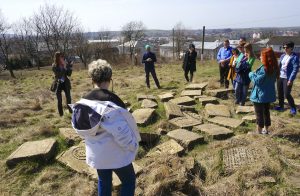![]() Ця сторінка також доступна українською.
Ця сторінка також доступна українською.
Introduction
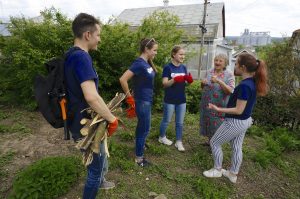
Ukrainian and American volunteers meeting a neighbor in the Rohatyn old Jewish cemetery. Photo © RJH.
This page summarizes and analyzes a set of interrelated projects led by a single organization which address multiple facets of overall site rehabilitation at the old Jewish cemetery in Rohatyn, in the Rohatyn raion of the Ivano-Frankivsk oblast in western Ukraine. At the time of this summary, some facets of the overall project have been completed or in continuing progress for a few years, other facets are currently in design and planning phases, and a few facets are intentionally set aside for future development. This summary describes the individual project tasks of concept development, site surveying and research, site cleaning and vegetation clearing, memorial design, signage design, plus project support and communication.
This page is intended as a reference for similar projects now in the planning stages in western Ukraine or beyond. Following a brief summary of the site, the material below describes the project and reviews its effectiveness together with a listing of issues encountered, approximate project costs, and ongoing risks. Related projects both in western Ukraine and elsewhere in Europe are also briefly mentioned, for comparison. At the bottom of this page are links to project documentation and to additional reference information about the burial site and related projects.
Read the overview to case studies of selected projects at Jewish burial sites in western Ukraine.
Project Summary
Project type: A set of overlapping projects at a single Jewish burial site, each focused on one aspect of rehabilitation and heritage of the site, which are planned, developed, and managed by a single heritage organization.
Location and site type: “Old” Jewish cemetery of Rohatyn, Rohatyn raion, Ivano-Frankivsk oblast, Ukraine. GPS: 49.40769 24.61589.
Description of the site: The cemetery perimeter is an irregular rectangular shape of approximately 440m length, enclosing roughly one hectare of area, on a hilltop with moderate slope.
Ownership and stakeholders: The cemetery site is owned by the municipality of Rohatyn. Stakeholders include the local civil community, the Ukrainian NGO Rohatyn Jewish Heritage, foreign descendants of Rohatyn pre-war Jewish and other families, historians, and students of Jewish culture.
Official heritage status: No current national or regional registration. The site is indicated on the Rohatyn city administration general development plan and map, it is specifically recorded in Rohatyn city files as “Старий Єврейський цвинтар (поблизу вулиці С. Бандери)”, and the cemetery is subject to several permission agreements for care of the site assigned by the Rohatyn raion administration to the Rohatyn city administration and by the city administration to the NGO Rohatyn Jewish Heritage.
Activists working on/at the site: Rohatyn Jewish Heritage (RJH), a registered Ukrainian non-profit organization based in Lviv, Ukraine. Contact info.
Other projects active at the site: This summary discusses all of the projects active at the cemetery, both in progress and in planning, which are led by a single organization: surveys, vegetation clearing, memorial, landscaping, signage, and communication. A headstone recovery project which returns recovered stone fragments from all over the city to this cemetery is detailed in case study 07 on this website; a summary and analysis of the communication project for all Jewish heritage sites in Rohatyn is detailed in case study 16 on this website.
Project Analysis
History of the site: Rohatyn’s first or “old” Jewish cemetery dates from the 17th century, and served the community and grew to cover a one-hectare site not far from the city center until it was closed due to overcrowding in the early 20th century; a second or “new” cemetery then opened north of the center and served until the Jewish community was destroyed in 1943. Sometime during the German occupation of WWII, thousands of headstones were broken and “harvested” from the old cemetery for use as construction material in Rohatyn. Following Ukraine’s independence, as headstone fragments surfaced from time to time, Jewish survivors of the Holocaust in Rohatyn and their families arranged with residents of Rohatyn to move the stones to the Jewish cemeteries; this effort significantly accelerated from 2011 with the involvement of the activists who would later form the Ukrainian NGO Rohatyn Jewish Heritage. In the late 1990s, Jewish survivors and descendants also raised funds and coordinated with the Rohatyn city administration to construct a partial retaining wall and complete perimeter fence around the cemetery, and erected a stele on the site which commemorates the lost Jewish community of Rohatyn. Since 2011 there are typically a few foreign visitors each year from the Rohatyn Jewish descendant community, but rarely do those visitors return, and occasionally Hasidic pilgrims visit the tombs of the renowned tsadiks in the cemetery.
Current features of/at the site: The cemetery is situated on one of the highest hills in the city, sloping moderately downward from a ridge near the eastern edge (the oldest section) to the western edge, and slightly downward from the northern edge to the southern. Except at the northwest corner, the cemetery stands above all of the surrounding terrain. The burial ground is bounded on three sides by rough-paved minor roads; two of those sides have post-war residential houses on the opposite side of the roads. The third road separates the Jewish cemetery from an old church graveyard. The ground slopes steeply from the fourth side of the cemetery down to a residential garden and small agricultural plots. The cemetery is fenced with low metal pickets and with now-missing gates; the fence (from the late 1990s) is decaying with several missing sections but still clearly identifies the cemetery perimeter. A handful of sandstone matzevot stand in the upper half of the cemetery, most near the high ridge; elsewhere, only a few stumps of original headstones remain, broken nearly flush with the ground surface. Headstone fragment recovery work has brought hundreds of large and small matzevot pieces to the site, most of which have been set down in the northwest quadrant of the cemetery. A large stone memorial monument stands on a wide base on the eastern ridge near the cemetery entrance, and a small family memorial is installed nearby. A large closed ohel was built over the graves of three prominent Rohatyn and Stratyn rabbis in late 2011, and a small open ohel was built over the presumed grave of another tsadik a few years later. Several large trees are grouped near the southwest fence inside the cemetery, and a few decorative hedges and shrubs were planted at the fence line by neighbors, but otherwise there is no intentional landscaping at the site.
Details of the project: The full project is detailed on the RJH project page. In summary, the project components are:
Concepts: Project concepts include a focus on the site as a shared cultural resource in Rohatyn and as a memorial for the living Jewish community there before WWII, as well as on project impact and process: modest changes to the current state of the site, and phased implementation to spread limited management and funding resources over time.
Site Surveys and Research: Largely complete, this phase included historical and legal research, cemetery perimeter and land profile surveys, and identification and location measurements of existing fixed objects within the site boundaries.
Site Clearing and Cleaning: An ongoing project component since 2018, with significant volunteer support this effort has removed heavy wild vegetation across the entire site, and cleared garbage and most of the construction debris accumulated over the decades since WWII. The work now focuses on seasonal trimming and clearing of fast-growing shrubs and grasses, monitoring and cutting new growth of poisonous plants, and the gradual reduction of residual tree and shrub stumps from past clearing work.

Scenes from the first major clearing of the old cemetery by volunteers, in 2018. Images © RJH and TMF.
Memorial Design: The proposed memorial design incorporates the hundreds of headstone fragments recovered from around the city of Rohatyn (now collected in one corner of the cemetery) with sufficient space for several times that number to be recovered and displayed in the future. The design is very low to the ground, leaving open views from anywhere in the cemetery, and uses common materials and simple tools and labor to assemble, while providing some protection for the stone fragments from groundwater at the site.
Landscape Planning: No detailed planning has begun for changes to the landscape in the cemetery. The memorial installation will prepare the adjacent surfaces to receive overlapping geosynthetic fabrics to minimize weed growth where paths covered with fine crushed rock will be installed. The overall concept calls for low and slow-growing ground cover to gradually replace the wild grasses and shrubs which currently overtake the cemetery each year.
Stone Conservation and Documentation: A comprehensive headstone conservation plan still requires advice and training from regional conservation experts, including academics in the architecture departments of Lviv Polytechnic University. Until those expert resources are available, recovered headstone fragments will be installed on the new cemetery memorial to slow their decay due to ground contact. The overall concept calls for permanent tagging, documentation (descriptive and photographic), and databasing to allow searches and the possibility of finding corresponding fragments from individual original stones.
Directional and Information Signage: Designs and placement plans have been proposed for different types of physical signs, including roadside directional signs, site identification signs, and signs which present information about the history of the cemetery and about the lost Jewish community of Rohatyn, including a map of the city’s heritage sites.
Fences and Gates: Although the existing fence is very worn and the gates have been lost, the project proposes no new fence construction until higher-priority components of the project have been implemented. Minor repairs will continue to be made as new problems with the old fence are noted.
Site and Project Sustainability: The estimated longevity of new features is addressed in each of the project components, so that budgets for maintenance, repair, and replacement can be outlined. Identifying and engaging long-term management of the site is a key requirement for the future of the cemetery, to date unfulfilled.
Project Support: Expenses associated with project design and management, including the formation and sustaining of the Ukrainian NGO Rohatyn Jewish Heritage (RJH), are covered through volunteer work and personal donations by the founders of RJH. A significant amount of the project manual labor each year is donated by local and foreign volunteers, including the Peace Corps in Ukraine. Other costs for tools, supplies labor, transportation, housing and meals for volunteer laborers, translations and interpreting, etc. are mostly covered through small donations from individuals and colleagues with allied organizations. Fundraising for these purposes is typically through appeals by the principals of RJH within the Rohatyn Jewish descendants group and on social media.
Communication: The public history facet of the cemetery project is addressed through information signage at the site, via the RJH website and its Facebook account, through information and artifacts related to the past Jewish community at the city’s local history museum, with in-person guided tours for Ukrainian and foreign visitors, and through a variety of other media including local journalism, internet mapping databases, interviews with foreign journalists and bloggers, and more.
Issues encountered in the project: The time and money resources available to manage, design, and implement the cemetery project, both from the RJH NGO and from the Rohatyn city administration, are inadequate to make significant visible progress each year. Incremental survey, clearing, and design work has been completed by the RJH NGO through 2020, but the next phases will require large expenditures for materials and probably for labor. Without significant infusion of funds, the next phases of the project can still proceed, but only over a span of many years.
Project costs, one-time and sustaining: Costs for the old Jewish cemetery project are often shared with other ongoing Jewish heritage projects in Rohatyn, which are summarized in RJH annual reports; see the 2019 year-end report for a typical summary, and the 2018 year-end report for the first complete vegetation clearing project at the old cemetery (US$6323 for tool investment and project operations). Implementation of the memorial design has been roughly estimated between US$6000 and US$18,000 for materials, plus labor (some of which will likely be volunteer). Other project components either have not been estimated or are entirely covered by volunteer work.
Current risks to preservation: With seasonal vegetation clearing and without severe weather events, the cemetery grounds and the standing and recovered headstones decay only slowly, much as they naturally would if the site were still cared for by the now-absent Jewish community. There are no known government or private legal threats to the site, which is recognized as local heritage by the city and the residents of Rohatyn. Enhancing the ability of the cemetery to promote its own status as shared cultural heritage would of course increase its value within the region and beyond, and thus encourage further preservation and protection.
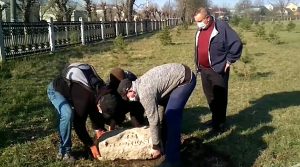
A headstone is returned to the new Jewish cemetery in Zolochiv by city staff in 2020. Video capture © Ihor Hrynkiv.
Related projects in western Ukraine: At the Jewish cemetery in Bolekhiv (Ivano-Frankivsk oblast), activists with a global descendants group and a US non-profit organization have organized preservation projects over the past twelve years, including vegetation clearing summarized in case study 06 and information signage summarized in case study 15 on this website; these projects were preceded by the construction of a full perimeter wall around the cemetery, as well as other heritage projects in the town and at mass grave sites in the cemetery and in a forest outside of Bolekhiv. In Zolochiv (Lviv oblast), residents and the city administration have been working together for several years to clear vegetation at the erased new Jewish cemetery, where a Holocaust survivor and other Jewish descendants built a memorial and a fence; the city is now also encouraging residents to report found Jewish headstones, and is helping to return those to the cemetery. In Nadvirna (Ivano-Frankivsk oblast), in addition to the memorial monument project summarized in case study 08 on this website, the Jewish descendants organization partnered with ESJF and local activists to construct a full perimeter fence and to clear the cemetery of overgrowth; ESJF has also conducted an aerial survey of the cemetery.
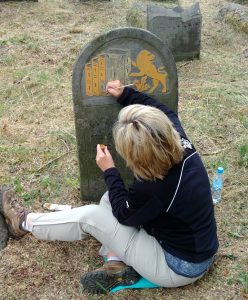
Restoring paint on a headstone in the Bagnówka Jewish cemetery. Photo © Heidi M. Szpek.
Related projects outside western Ukraine: Elsewhere in Ukraine, Hryhoriy Arshynov, a Jewish heritage activist living and working in Ostroh (Rivne oblast) has organized and completed several projects at the Jewish cemetery there, including vegetation clearing and maintenance, recovery and resetting of many headstones, the collection and presentation of headstone fragments in memorial walls, the rebuilding of an ohel, as well as perimeter fencing and signage; these projects have run in parallel with extensive restoration works at the Great Maharsha Synagogue in town. Leaders of the Bagnówka Cemetery Restoration Project (BCRP) and their colleagues have been active since 2015 at the Bagnówka Jewish cemetery in Białystok, Poland in a wide variety of significant heritage projects such as historical research including analysis of WWII Luftwaffe aerial photos, headstone transcription and translation, headstone resetting plus repair and conservation, renewal of headstone colored paint based on careful sampling of residual traces from past decoration, extensive communication to promote the cemetery as a cultural heritage resource, and the development of best practices in cemetery restoration. The small historic Jewish cemetery in Rožna Dolina, Slovenia (formerly known as Valdirose and forming a part of Gorizia in what is now Italy) has been studied for a multi-faceted cross-border restoration project incorporating archival research and records digitization, excavation of buried headstones, headstone resetting and conservation; initial work has begun and the project now seeks roughly US$500k in government and institutional funding.
References
- Old Jewish Cemetery Rehabilitation Project – a detailed description of the overall project to preserve and promote the cemetery, including development of a memorial incorporating the recovered headstone fragments, on the website of Rohatyn Jewish Heritage (RJH)
- Jewish Cemeteries of Rohatyn – an overview of the history and current status of the Jewish cemeteries in Rohatyn, on the website of Rohatyn Jewish Heritage (RJH)
- Rohatyn Jewish Heritage Projects: An Overview – a summary with links to plans and progress for all heritage projects managed by Rohatyn Jewish Heritage, on the website of Rohatyn Jewish Heritage (RJH)
- Between Lviv and Ternopil – a photo and text essay from 2017 covering the Rohatyn old Jewish cemetery and mass grave sites plus Jewish heritage in three other western Ukraine locations, from Christian Herrmann’s Vanished World blog site

